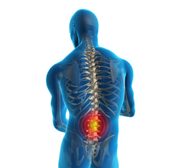Annular Tears
What is an Annular Fissure?
If you were to look at a picture or model of the spine, you would see that between each vertebra is a disc of tissue that looks like a tire. This disc is a natural shock absorber that limits the stress on the spine when twisting, lifting, bending, etc. The inside of this “tire” is filled with a gelatinous material (called the nucleus pulposus) that flexes and stretches as the body moves. A hard coating of protective thick material, called the annulus fibrosis, surrounds this nucleus. The annulus has nerve fibers but unfortunately no blood supply (“avascular”), which is why injury to the discs are very difficult to heal, much less treat.
The outer edge of the annulus, or the “treads on the tire,” is filled with blood vessels and nerves. As you get older, that inner gelatinous material can dry out and eventually cause a condition called “degenerative disc disease.” This nucleus pulposus diminishes inside the disc, causing the vertebrae to move closer together. Imagine that tire losing air, reducing the shock absorption to the rest of the vehicle or body. This disease causes the nerves to come closer together.
Actions such as twisting, bending and heavy lifting put pressure on the outer rings of the annulus and can weaken them. The fiber in the outer ring can actually rip or tear from the stress, creating a tremendous amount of pain. Imagine a thick rubber band that his been dried out and made brittle by the sun.
The pain from an Annular Fissure is also referred to as an Internal Disc Disruption. It comes from the gelatinous material on the inside touching the pain-carrying nerve-fibers on the outer edge of the annulus. When the inner material reaches those nerve centers, it causes a tremendous amount of pain. If the tear becomes big enough that the nucleus pulposus reaches the outside of the disc, that is called a disc herniation. This can cause back or leg pain and weakness. If the fissure is located in the lumbar spine, it can affect the legs and is called Sciatica. If it is located in the cervical spine it is called Cervical Radiculopathy.
What Causes of Annular Fissures
Annular tearing generally comes from a combination of trauma and degeneration. Genetics may also have an influence on the development of this syndrome in that your body could develop weak annulae. Small tears can form from simply sitting or twisting. Certain exercise or heavy labor may also contribute greatly to these tears. The standard wear and tear on a body can have more of a lasting effect than you ever realized.
Types of Annular Fissures:
The three main types of annular fissures are listed below in order of progression:
- The rim lesion – A horizontal tear of the outer annular fibers of the disc near their attachments into the ring apophysis. They are often associated with bone spurs.
- The concentric tear – The splitting of the lamellae of the annulus in a circumferential direction. Trauma (not aging or degeneration) is usually the major cause of this type or tear, specifically from excessive twisting as in a golf swing or throwing a discus in track & field. Research shows that for reasons yet undiscovered, the lamellae lose the ability to “stick together.” This loss of adhesion is called delamination.
- The radial tear – A horizontally oriented tear that goes from the inner nucleus pulposus through the entire outer region of the disc. These are significantly associated with the aging process and disc degeneration.
The symptoms you might see with annular fissures are swelling, pressure, pain and sharp, stabbing sensations.
Spinal Decompression Therapy and Annular Fissures
If you have read our previous articles on Spinal Decompression Therapy, you will know that our tables have a computer that controls the “distraction force” and the spine is slowly stretched to provide gentle and painless decompression of the “jammed” spinal joints and discs.
This “separation” creates a “sucking” vacuum that directs much-needed nutrients, oxygen and fluids into the injured annular fissure and nucleus propulsus (which is avascular as explained earlier) and this can begin the annular fissure healing process. In essence, the interior of the disc receives the hydration and nutrients it needs to combat the drying out process that takes place in your nucleus pulposus and could lead to an annular fissure.
Some people also present to us with excessive “movement disorders” of ligaments in the lower spine or an annular fissures that are very large and precarious. In this case, our treatment may be contra-indicated initially until your condition is stabilized and we can help you with this too. If you’ve been diagnosed with an “annular fissure” or a disc “protrustion”, “herniation” or “bulge”, Spinal Decompression Therapy can help. Of course, we need to make sure you are an appropriate candidate for the non-invasive procedure. If you have found that other treatments have not helped, it is time to try Spinal Decompression Therapy.
Suffering From an Annual Tear?
We Can Help!
Call Us Today (021) 436 – 0009



